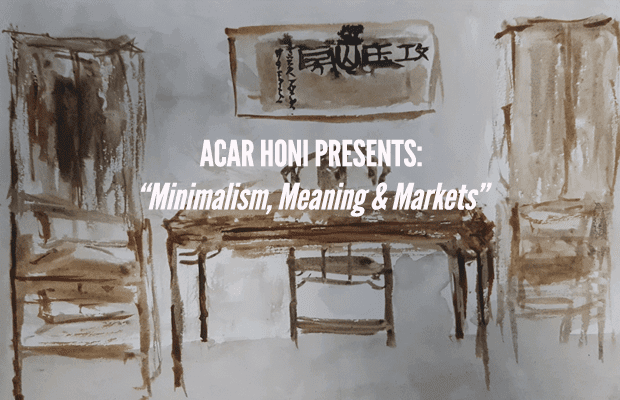While lifestyle blogs and marketing regimes have come to fill the consumer consciousness, minimalist movements have become the new trending fashion. The seemingly unstoppable rise of Marie Kondo has blasted minimalism into the Western cultural imaginary. Despite the multiplicity of these movements, minimalism and its aesthetics have been bound by a singular core principle: one of subtraction. Yet, as its path in modernity continues, the realisation dawns that nothing is sacred in the age of global capital.
Subtraction, more familiarly understood in the West as ‘reduction’, fills the heart of minimalistic ideals and forms – the reduction of excess or the unnecessary until only the essential elements remain. Within the sphere of Modernism, the seminal works of Truitt to Malevich to Pollock in the Abstract Expressionist and Minimalist movements, all make up the foundations of this principle. However, the philosophy of subtraction is deeply rooted in the traditions of East Asia, namely Zen Buddhism and Taoism – prioritising self-cultivation over complex rituals.
Minimalism’s ascent was not free of political considerations. At a time when social movements like the Black Panther Party were heavily repressed, the US hoped to cultivate an image of openness in opposition to the supposed repressiveness of the socialist bloc. Covert CIA patronage for Abstraction in the 1960s helped popularise it on a global scale, highlighting the “freedom” of artists in the capitalist world when compared to the allegedly restrictive nature of Soviet socialist realism.
The engagement of pioneers in the movement with Asian influences is well documented. But alongside Malevich, Pollock or Truitt, it is important to note the contributions of their contemporaries from the East-Asian diaspora. These include the revolutionary works of Toshiko Takaezu and Tadashi Sato. The work of Takaezu represents a genuine reinvention of East-Asian principles and a reconnection with cultural heritage: the forms of her pottery are fundamentally modernist, yet reminiscent of Zen traditions. Their works represent an important contribution to the style of Abstraction, where the autonomy of the artist or the art itself is prioritised above realism. Yet, these artists remain comparatively obscure, being largely sidelined due to the cultural dominance of their Western contemporaries.
Despite their creative importance and culturally-ingrained roots, traditional sacrality and context are easily discarded in the neoliberal era. The eventual co-option of minimalist aesthetics by the neoliberal apparatus was more than just a singular act of cultural desecration. The striking simplicity of minimalism and its psychological imprint provided fruitful ground for competing firms to utilise in marketing their brands. Moreover, minimalism provided a convenient cultural backdrop for the notions of efficiency and eliminating unproductive excess that constitute the inherent logic of neoliberalism. The clean edges and sleek lettering of advertisements are now indelibly etched into the consumer consciousness. Without cultural context, minimalism becomes the deification of the excess that contemporary self-help blogs seek to criticize.
It is precisely here, where aesthetic continuity exists, but contextual or cultural solidity remains in the void. A hollowed imitation of its forebearer, the traces of Minimalism’s origins now reinforce orientalist tropes. It is here seen with the case of Japan. Its existence is not one of hapless victimization – Japan’s agency is present on world markets and in cultural exchange. Instead, an idealized image and abstraction is reinforced by neoliberal minimalism, where Japanese culture is subjected to the Western gaze.
Often articles from the likes of Insider fetishise Japan’s ‘obsession with minimalism’ – a fetishisation immanent in the Western obsession with Marie Kondo. Both are underpinned by an orientalist and one-dimensional view of Japan’s alleged cultural homogeneity, and its separation from the corporate (and only) minimalism. Japan’s history, however, proves far richer than the myth of singularity. Though it is true that Zen is quite thoroughly integrated in certain aspects of Japanese society, Japanese culture dates back thousands of years and minimalist art only serves as one of its facets. Comments that portray minimalist Japanese prefectural flags as reminiscent of corporate logos, rather than the opposite, ultimately obfuscate minimalism’s cultural origins.
As Japan is pinned as the uniquely, but also not quite true minimalist culture, China is nearly always juxtaposed as its polar opposite – one where maximalism and the lust for the excess defines art. Investigating Chinese art and philosophy disproves such homogeneity, considering Zen (Chán), as well as Taoism both have their origins in Chinese history. One such example is that of the furniture of the Ming dynasty, emphasizing the accentuation of raw material form and simplicity.
Global capitalism’s desecration of culture is imposed upon racialised populations not just via ideals but also through material means. China’s integration into the world market and its function as a repository of labour for manufacturing served to further the orientalist constructions of China’s inherent maximalism. It is only now that artists are able to re-engage and reinvent traditional paradigms. We see the emergence of various architectural and design practices such as Neri&Hu, a Shanghai-based architectural practice dealing with traditional minimalist design elements in the contemporary era.
They are one of many that demonstrate the efforts to functionally resist, at least temporarily, the cultural desecration and stagnation imposed by global capital. It is not a nostalgic cry for help when artists like Takaezu and Sato, nor Neri&Hu, create pieces reminiscent of a long-gone past. Instead, they yearn to find the new in the old, to illuminate our connections to the past rather than to resurrect the cold and lifeless. On the homepage of Neri&Hu’s website lies a simple quote from Antoine De Saint Exupéry:
“We don’t ask to be eternal beings, we only ask that things do not lose all their meaning.”





